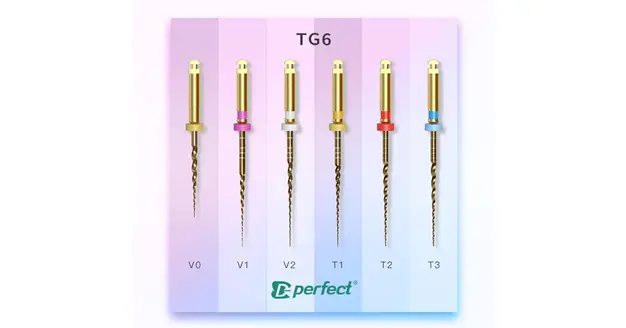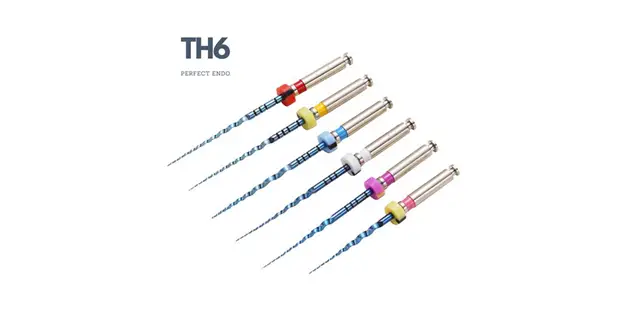The success and effectiveness of dental procedures depend on the instruments used. A root canal is not the exception. This complex procedure largely depends on the rotary files used by a dental practitioner. In this post, we’re going to focus on ProTaper rotary files and why they’re so important.
What are ProTaper rotary files?
ProTaper rotary files are instruments used by dentists when performing root canals. The main objective of these tools is to shape and clean the root canal and prepare it safely and effectively. ProTaper rotary files are well-known for their cutting efficiency. What makes ProTaper files stand out is that each instrument comes with changing percentage tapers over the length of the cutting blades. In practice, this design improves cutting efficiency, flexibility, and safety. At the same time, the use of these files decreases the rotational friction between the blade of the file and dentin.
The development history of ProTaper rotary files
The story of these devices began in 1988 when Walia et al. introduced corrosion-resistant alloy to the manufacturers for the purpose of producing NiTi rotary files. Before that, these instruments were made of stainless or carbon steel. These rotary files lacked flexibility and were prone to inducing errors and complications. The introduction of NiTi rotary files allowed practitioners to reduce the risk of error due to greater flexibility and precision. Since the 90s, NiTi rotary files have undergone various changes regarding design, construction, and shape. We can narrow down the history of NiTi rotary files into five generations:
- First-generation – introduced in the mid-90s, created smooth root canal walls, but multiple files were required to achieve desired outcomes.
- Second-generation – introduced to the market in 2001, had greater cutting efficacy than 1st generation, but some of them had a tendency to break during usage.
- Third-generation – introduced in late 2007 and were made with heating or cooling technologies on NiTi to improve the safety of the rotary files
- Fourth-generation – marks the use of single-file technique to achieve cleaning and shaping goals. The single-file system decreases the bacterial number in the root canal significantly.
- Fifth-generation – the canal shaping efficiency is improved by the offsetting center of rotation. These files generate a mechanical wave of motion that is distributed along the length of the file, thus improving cutting and removing debris.
Should rotary files be used once?
Ideally, rotary files should be used once only. A single usage of a specific rotary file ensures the best efficacy and safety. But many practitioners use rotary files multiple times. They sterilize the rotary files and reuse them on multiple patients in order to save up on the costs. However, in some countries and regions, ProTaper rotary files are required for one-time use.
What are the concerns with the multiple uses of rotary files?
As seen above, some practitioners often reuse rotary files, but this practice raises a few concerns. For example, mechanical properties may change after shaping a canal or following the first sterilization cycle.
When that happens, the files can separate inside the tooth canals and cause blockages that prevent proper disinfection. The first use of the rotary files may also impair cutting efficiency, whereas multiple uses also raise concerns of accumulation of cyclic or metal fatigue.
Moreover, the loss of cutting efficiency also reduces cleaning ability. There’s also the risk of cross-contamination due to the possibility that cleaning or disinfecting methods may not be enough to get rid of all infectious agents.
The easiest way to prevent the rotary files from separating and problems regarding sterilization are to opt for single-use devices.
Dental Perfect has excellent ProTaper rotary files for you.
Dental tools and instruments often determine the outcome of the procedure. For that reason, the ProTaper rotary files should be top-notch. Below are several examples of excellent ProTaper endodontic files from Dental Perfect.
TG6

ProTaper rotary file TG6 is made of nickel-titanium and gives amazing flexibility. It’s a heat-treated rotary file system with the gold standard. Heat treatment improves the performance of the file. The greatest advantages of TG6 are tough blades, 200% to 500% improved fracture resistance, and strong surface antioxidant activity.
TH6
These are heat-treated rotary files with the blue standard. The most important features of this rotary file system include variable taper and improved cross-section. This ProTaper rotary file is compatible with Dentsply ProTaper universal system, but the cross-section aspect is much better, thus enhancing the efficiency of cutting and finishing files. It is also a great substitute for ProTaper and features a non-cutting efficiency tip that protects the root canal to prevent fractures.

Kiddo
Kiddo system is specifically designed for children and root canal of primary teeth. The files feature a special tip design that helps prevent damage and irritation to sensitive and delicate tissues around the baby teeth. The length of a tip is 16mm, meaning it’s suitable for all children.
Protaper rotary files can work well with Endodontic Devices.
Dental Perfect rotary endodontic files are compatible with endodontic devices such as ZR-RAP. This particular instrument can work as an endomotor for enlargement and preparation of root canals, but it can also serve for the measurement of the length of canals. The wireless device has a sturdy and durable construction, and it also happens to be mute. ZR-RAP features an adjustable OLED screen and a preset file program. For additional ease of use, the device has a 340° adjustable contra-angle. At the same time, contra-angle is highly efficient but doesn’t consume a lot of power. In other words, ZR-RAP is efficient, fast, precise, adjustable, and easy to use.

Conclusion
ProTaper rotary files have high cutting efficiency and a low risk of error. They are a safe and precise instrument for a root canal. Dental Perfect rotary files systems are made to accommodate different needs and perform cleaning and shaping of a root canal in an effective and safe manner. The brand adheres to the latest standards and tech innovations to create outstanding dental instruments.




